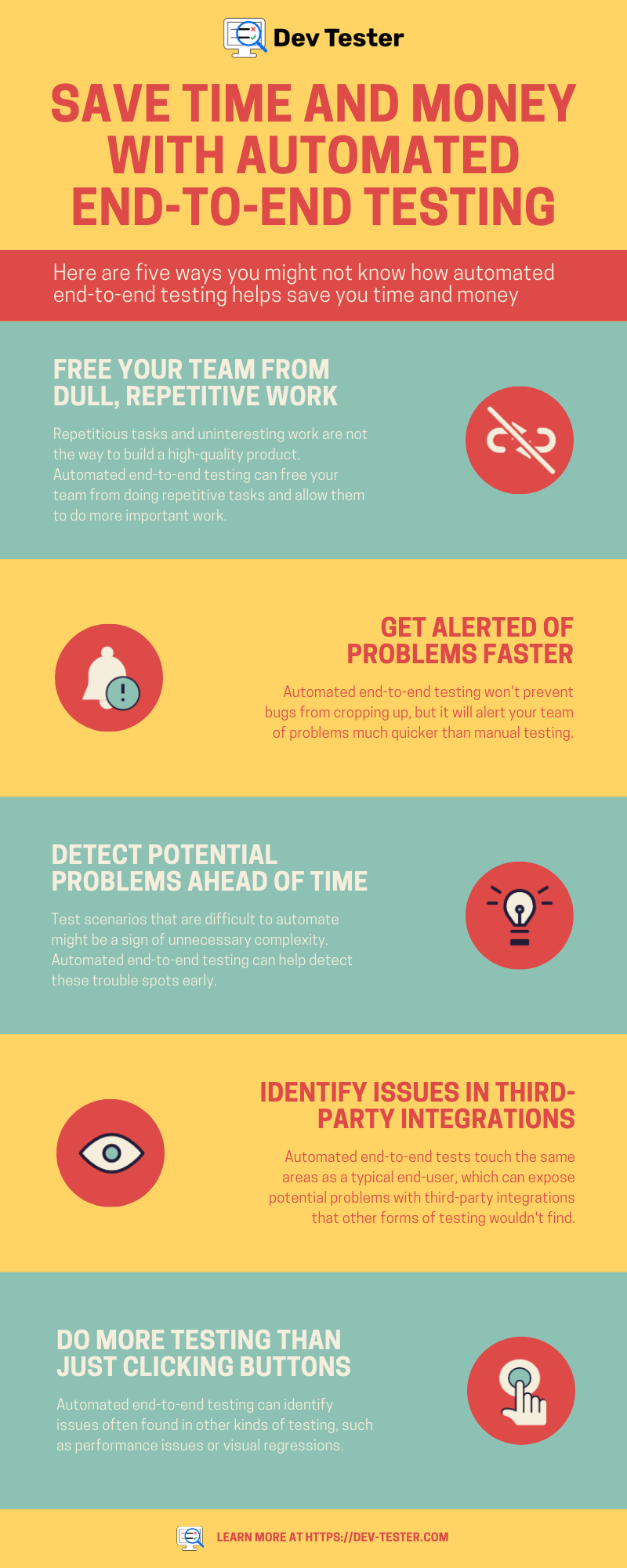Every day, more and more organizations that build software are looking at test automation to help them quickly deliver quality applications for their customers. In a 2020 survey by Perforce titled The State of Test Automation Today, 44% of respondents mentioned they are planning to invest in test automation within the next year.
If you're looking to boost your organization's test automation processes, chances are you might have some questions about how to invest in it. Unfortunately, integrating automation in your existing environment isn't as simple as adding it as another task on your to-do list. Planning to incorporate test automation as part of your team's workflow comes at an upfront cost, taking time and money to get your team and company up to speed.
In another 2020 survey about the state of open source testing by Tricentis, 50 percent of respondents mentioned that time was their biggest impediment in implementing functional test automation in their organization. Additionally, 40 percent said training and skills as another impediment, along with 27 percent of respondents pointing to tool costs. These concerns point out some of the main obstacles to adopting test automation in the workplace.
Compared to other forms of QA, test automation doesn't come cheap and will require lots of effort to have a working implementation that improves your application and provides value. However, an excellent test implementation will pay off in the form of finding and fixing bugs quickly, delivering higher quality products, and satisfying your users. You'll eventually have a return on your investment, and then some.
One of the main issues with overcoming the initial cost concerns is that it's challenging to have direct proof of the benefits since they often arrive over time. At best, you'll find dozens of articles with little information beyond "automated end-to-end testing saves time" or "automation reduces the amount of bugs in your application." Those benefits are apparent, but there's a lot more beyond those short soundbites. Here are five ways automated end-to-end testing can save you time and money.
1) Free your team from dull, repetitive work
In many companies, non-QA folk view testers as low-skilled employees who only do simple button mashing while performing manual testing. It couldn't be any farther from the truth, but it's an unfortunate reality in many organizations. In these places, the daily work for QA often consists of repetitious tasks and tedious tasks.
These same companies usually find out the hard way that this is not the way to build a high-quality product. No one wants to spend their entire workday looking at the same screens, performing the same actions over and over again. It's a sure-fire way to burn out your team. You need to give your team the space to explore and find better ways to test.
Automated end-to-end testing can free your team from doing repetitive tasks and allow them to do more meaningful work. By automating the repetitive stuff, your team can use that time to do the work that yields much more value than manual testing alone. Testers can spend more time improving your products through exploratory testing or making adjustments that increase productivity between development and QA. These improvements will save the organization time and money in the long run.
2) Get alerted of problems faster
Despite our best intentions, no software product will escape the cruel reality of bugs and defects. Problems will inevitably arise, no matter how much effort you put into test coverage for your application. Since issues will crop up at any time, you need to be in a position to confront them as early as possible. Tackling these problems as soon as you see them gives you the best chance to fix them quickly when the affected area is still fresh in the minds of the developers and testers.
The longer a bug lingers before it's discovered, the more time and money you'll need to debug and fix the issue. The problem when there's not enough automated testing in an organization is that you'll often discover bugs later in the process, leading to massive delays. For example, I worked once with a team that solely did manual testing. QA often found bugs weeks after the team developed a feature. Development had moved on and forgotten about that work, and the cost in context switching added up to the project getting nearly three months behind their original schedule.
While automated end-to-end testing won't prevent bugs from cropping up, it will alert your team of potential problems much quicker than manual testing. If your development process includes continuous integration, it can automatically run your test suite after each change and send notifications if something's not working as expected. Knowing about a problem now takes much less time and money to deal with versus discovering it weeks later.
3) Detect potential problems ahead of time
Test automation can let you know of problems in the form of failed tests. However, these occur after the test execution happens. It's better than not being alerted about the issue at all, of course. But depending on how long your tests take to complete, the delay might not be ideal. For instance, we've all done some last-minute work before leaving for the weekend, only to find a broken test suite come Monday morning. It's not a great way to begin the workweek.
What if automation could caution you about potential trouble before you even write your test scenario? Automated end-to-end tests provide that "superpower" as a hidden benefit that not many testers think about. When you sit down to think about how to automate your testing, you must think deeply about how the application works and all the steps you need to take from start to finish. During this time, you or your team might discover that the scenario contains too many confusing steps. If the people who work on your product every day find something complicated, chances are it's much more complicated for your users.
Suppose your team finds it difficult or almost impossible to automate a full end-to-end flow for your application. In that case, it might be a sign of unnecessary complexity in the application under test. Not only is this complexity challenging to deal with during development and testing, but it can also signify a problematic user experience for your customers. Detecting these trouble spots early can avoid your team investing too much time in developing and maintaining functionality that will likely get scrapped in the future.
4) Identify issues in third-party integrations
These days, many software applications integrate with third-party solutions to provide additional functionality. Instead of building a payment processor or setting up user analytics from scratch, you can plug in someone else's service with little effort. For developers, these external services are a tremendous boost to their productivity. However, things are less rosy for testers because these external services provide additional failure points in your system.
If your applications use a third-party service to integrate a piece of core functionality for your product, you'll want to know of problems with that integration sooner rather than later. You don't want your customers discovering a poorly-performing integration when it's in production. Since automated end-to-end tests touch the same areas as a typical end-user, it can expose potential problems with third-party integrations that other forms of testing wouldn't find.
For example, one application I worked on used an external service to handle searching for a large database. One day, the service changed how it indexed its data and was returning less-than-ideal results. When testing manually, everything looked fine since the service did return something and wasn't failing. But our end-to-end tests uncovered the issue of poor search results since it wasn't returning what we expected. I estimate that finding this problem early saved the company thousands in potentially lost revenue thanks for customers not finding what they needed.
5) Do more testing than just clicking buttons
One of the most common mistakes organizations make when turning to automated end-to-end testing is thinking that it's only about automating user actions. The focus is solely on writing scripts that click buttons, fill in text fields, and verify results. The bulk of end-to-end testing indeed does this, but it also does a lot more testing than you think. End-to-end testing can identify issues often found in other kinds of testing.
An example is detecting performance issues in an application. You might notice that your automated test runs take longer and longer every time they execute in your system. Those slower test runs might mean that the application under test is taking longer to perform each step, and investigating further can uncover performance regressions unrelated to the test suite. Another example is analyzing failed tests and discovering a small UI bug that's almost impossible to detect when testing manually.
While automated end-to-end testing isn't a substitute for a well-balanced testing strategy, it can help test other areas outside of user actions. Early in your automation journey, it can save you time and money without investing in other dedicated forms of testing. However, keep in mind that you'll still need to have a balanced testing strategy that can include dedicated performance or visual testing if they make sense for your situation.
Summary
Many companies are looking to boost their productivity and quality by integrating test automation into their existing workflow. However, adding any new processes into the way an organization currently operates comes at a price. It takes time, money, and lots of effort up front, causing some to rethink their plans or hold off on automation altogether.
While there's an upfront cost - sometimes a high cost - to introducing test automation, a useful implementation will eventually return that time and money investment in the long run. You'll find and fix bugs quicker, spending less time putting out fires and more time delivering a quality solution for your customers. Sometimes it isn't easy to believe that the upfront investment will pay off since the benefits come over time, but they eventually arrive.
This article points out a few different ways automated end-to-end testing can improve your workflow that may not be immediately obvious. Your team can get free from repetitive tasks and into higher-value and more exciting work. You'll discover problems sooner and fix them even before the team implements them into your product. Also, end-to-end testing can indirectly test multiple facets of your application beyond clicking around, from performance to visual testing.
These reasons are just a few ways that automated testing helps. Every organization will discover even more benefits for their situation when using a properly-implemented test automation strategy. Combined with a balanced approach containing other types of testing like manual or exploratory will offset any upfront cost quicker than you might expect.
What other ways have you seen automated end-to-end testing to save time and money? Let me know your experiences in the comments section below!
Struggling with automation? I can help!
If you're struggling with your test automation project and looking for some guidance or hands-on assistance, I can help you get on the right track. With over 16 years of software development and automation experience, I can help set up a robust and reliable automation strategy that will help you deliver quality products faster.
Share this information with your team
If you know someone who needs some nudging about the benefits of automated end-to-end testing, please share this infographic with them!





